Related Research Articles

The Territory of Heard Island and McDonald Islands is an Australian external territory comprising a volcanic group of mostly barren Antarctic islands, about two-thirds of the way from Madagascar to Antarctica. The group's overall land area is 372 km2 (144 sq mi) and it has 101.9 km (63 mi) of coastline. Discovered in the mid-19th century, the islands lie on the Kerguelen Plateau in the Indian Ocean and have been an Australian territory since 1947.

The Tasman Sea is a marginal sea of the South Pacific Ocean, situated between Australia and New Zealand. It measures about 2,000 km (1,200 mi) across and about 2,800 km (1,700 mi) from north to south. The sea was named after the Dutch explorer Abel Janszoon Tasman, who in 1642 was the first known person to cross it. British explorer Lieutenant James Cook later extensively navigated the Tasman Sea in the 1770s during his three voyages of exploration.
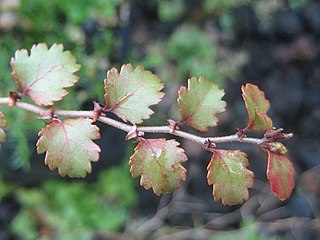
Antarctic flora are a distinct community of vascular plants which evolved millions of years ago on the supercontinent of Gondwana. Presently, species of Antarctica flora reside on several now separated areas of the Southern Hemisphere, including southern South America, southernmost Africa, New Zealand, Australia, and New Caledonia. Joseph Dalton Hooker was the first to notice similarities in the flora and speculated that Antarctica had served as either a source or a transitional point, and that land masses now separated might formerly have been adjacent.

Buprestidae is a family of beetles known as jewel beetles or metallic wood-boring beetles because of their glossy iridescent colors. Larvae of this family are known as flatheaded borers. The family is among the largest of the beetles, with some 15,500 species known in 775 genera. In addition, almost 100 fossil species have been described.
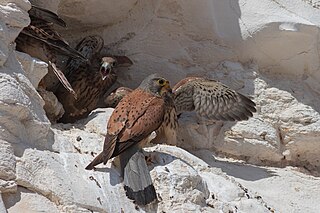
The term kestrel is the common name given to several species of predatory birds from the falcon genus Falco. Kestrels are most easily distinguished by their typical hunting behaviour which is to hover at a height of around 10–20 metres (35–65 ft) over open country and swoop down on ground prey, usually small mammals, lizards or large insects, while other falcons are more adapted for active hunting during flight.

Mallee are trees or shrubs, mainly certain species of eucalypts, which grow with multiple stems springing from an underground lignotuber, usually to a height of no more than 10 m (33 ft). The term is widely used for trees with this growth habit across southern Australia, in the states of Western Australia, South Australia, New South Wales and Victoria, and has given rise to other uses of the term, including the ecosystems where such trees predominate, specific geographic areas within some of the states and as part of various species' names.

The chocolate wattled bat is a bat in the family Vespertilionidae. It is found only in Australia, including the island Tasmania, and widespread in southern regions. It is known to reside from sea level to at least 1,570 metres (5,150 ft) in Victoria.
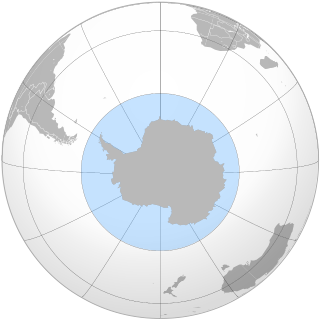
The Southern Ocean, also known as the Antarctic Ocean, comprises the southernmost waters of the world ocean, generally taken to be south of 60° S latitude and encircling Antarctica. With a size of 20,327,000 km2 (7,848,000 sq mi), it is the second-smallest of the five principal oceanic divisions, smaller than the Pacific, Atlantic and Indian oceans, and larger than the Arctic Ocean.

The Ulodidae are a family of beetles belonging to Tenebrionoidea. They are native to the Southern Hemisphere, with species found in Australia, New Zealand, New Caledonia and Chile. Larvae and adults are generally found on dead wood or fungus associated with rotting wood, and are mycophagous. There are approximately 40 species in 16 genera.
Michele Mari is an Italian novelist, short story writer, academic critic and poet. The son of a Milanese industrial designer and artist, Enzo Mari, Mari teaches Italian literature at the Università Statale di Milano; he is considered one of the leading experts of 18th century Italian literature.

Temognatha alternata is endemic to Queensland, Australia. Little is known of this spectacular beetle which has never been formally described, as the name is taken from that given by Lumholtz without any description.
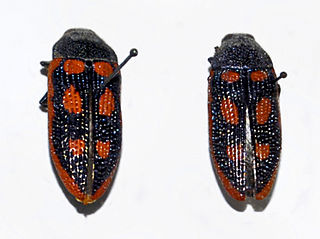
Stigmodera is a genus of beetles in the family Buprestidae, the jewel beetles. It is a large genus that some authors divide into three separate genera. Others keep them together, making Stigmodera a genus of some 550 species. Most are native to Australia and a few occur in New Guinea.

The wildlife of Antarctica are extremophiles, having adapted to the dryness, low temperatures, and high exposure common in Antarctica. The extreme weather of the interior contrasts to the relatively mild conditions on the Antarctic Peninsula and the subantarctic islands, which have warmer temperatures and more liquid water. Much of the ocean around the mainland is covered by sea ice. The oceans themselves are a more stable environment for life, both in the water column and on the seabed.

Stigmodera cancellata, common name Red Spotted Jewel Beetle, is a species of beetles in the family Buprestidae.

The Great Southern Reef is a system of interconnected reefs that spans the southern coast of continental Australia and Tasmania and extends as far north as Brisbane to the east and Kalbarri to the west. It covers 71,000 km2 (27,000 sq mi) of ocean and straddles five states, running along the coast for 8,000 km (5,000 mi).

Ninox boobook ocellata is a subspecies of the Australian boobook, which is also widely known as the southern boobook. The southern boobook is the most common and smallest owl on the Australian mainland.

The southern greater glider, also known as the southern and central greater glider, is a species of large gliding marsupial native to the forests of southeastern Australia. It is a vulnerable species per the IUCN Red List classification, but since 5 July 2022 is listed as endangered under the EPBC Act in Australia. The main threats to its survival are climate change and logging.
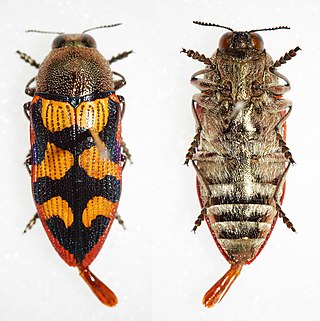
Castiarina simulata is a species of beetle in the jewel beetle family, Buprestidae, found in Western Australia, South Australia and Victoria.
Temognatha aestimata is a jewel beetle in the family Buprestidae, found in Victoria. It was first described in 1898 by Charles Kerremans as Stigmodera aestimata.
Temognatha affinis is a jewel beetle in the family Buprestidae, found in New South Wales. It was first described in 1868 by Edward Saunders as Stigmodera affinis.
References
- ↑ "Occurrence records". Atlas of Living Australia.